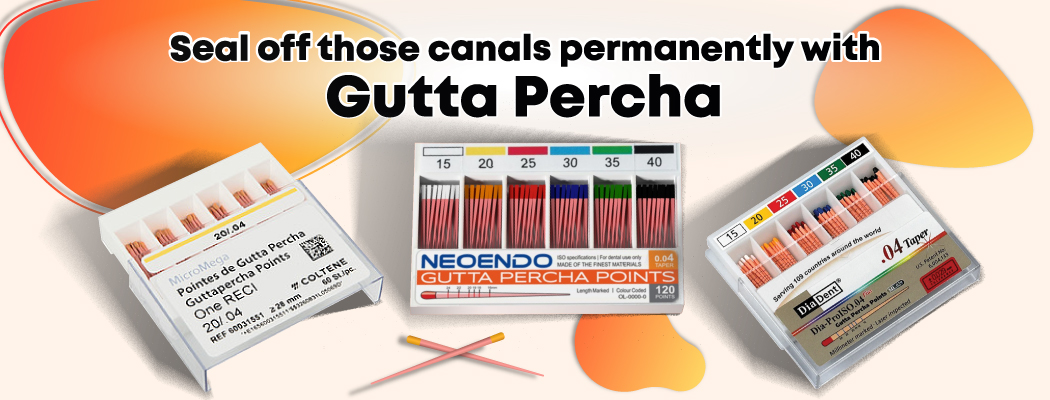Especially in root canal therapy, gutta percha is a substance that is frequently used in dentistry for a variety of functions. It is a natural polymer made from the sap of the Southeast Asian-native Palaquium tree.
Here are some details regarding gutta percha and its dental applications:
- Cleaning and Shaping: Gutta percha is largely utilized in the treatment of root canals as a filler material. The tooth's infected pulp is eliminated, and the root canal system is then cleaned, shaped, and sterilized. In order to close the root canal space and stop reinfection, gutta percha is heated and compacted into a rubbery, thermoplastic form. It helps preserve the integrity of the tooth structure and creates a tight seal.
- Obturation Techniques: Dentists employ a number of methods to obturate the root canal space before filling it with gutta percha. Vertical condensation and lateral condensation are the techniques that are most frequently used. In lateral condensation, an accessory gutta percha cone is introduced beside the master gutta percha cone in the main canal. They are then compressed with the use of specialized equipment. Using a heated plugger, vertical condensation, often referred to as warm vertical compaction, involves heating and compacting gutta percha.
- Temporary Filling Material: Gutta percha can also be used as a dental temporary filling. In order to retain the function of the tooth and prevent contamination until a permanent restoration can be completed, a softened gutta percha material can be inserted in the access opening or cavity when a tooth needs temporary protection or sealing between dental visits.
- Endodontic Posts: Endodontic posts can be made by mixing gutta percha with dental cement. Particularly when the tooth structure is compromised or severely injured, these posts are put into the root canal space to give stability and support for the eventual restoration, such as a dental crown.
In endodontics, the area of dentistry that deals with treating dental pulp and root canals, gutta percha is a crucial component. Due to its biocompatibility, simplicity of usage, and capacity to create a trustworthy seal within the root canal system, it has been extensively employed for many years.
Although gutta percha is frequently used and regarded as safe, certain patients may have particular sensitivities or allergies to the substance. When choosing materials for dental operations, dentists use prudence and take into account patient-specific considerations.
Benefits:
A natural substance called gutta percha is made from the latex of several plants, particularly the Palaquium gutta tree. It has been utilized for many years in a variety of applications, primarily in engineering and dentistry.
Following are a few advantages of gutta-percha:
Dental Applications: Endodontic operations, such as root canal treatments, frequently involve gutta percha. After the contaminated pulp has been removed, it is used to fill and seal the root canal space. Dental benefits include, among others:
- Biocompatibility: Gutta percha is biocompatible and well-tolerated by humans, which lowers the possibility of allergic reactions or other negative side effects.
- Thermoplasticity: It may be heated to soften and become easily moldable into the shape of the root canal space.
- Chemical resistance: Gutta percha resists chemical deterioration, resulting in a seal that is stable and long-lasting.
Electrical Insulation: Gutta percha is used in electrical and telecommunications applications due to its high electrical insulation qualities. It is a substance that can be used to insulate wires, cables, and other electrical parts. The advantages comprise:
- High dielectric strength: Gutta percha offers insulation and prevents electrical shorts by withstanding high voltage levels without conducting electricity.
- Thermal stability: It is suitable for electrical systems that produce heat since it can resist high temperatures without suffering considerable damage.
Water Resistance: Gutta percha is extremely water and moisture-resistant, making it helpful in a variety of applications where waterproofing is crucial. Several advantages include:
- Impermeability: It serves as a barrier to prevent water from entering, preventing harm to underlying materials or buildings.
- Stability in moist environments: Gutta percha maintains its stability and functionalities even when exposed to moisture.
Biocompatibility: Gutta-percha is said to be biologically inert, which means that when it comes into contact with living tissues, it doesn't cause any negative reactions or inflammation. To assure compatibility with the human body in medical and dental applications, this characteristic is particularly crucial.
Malleability: Gutta percha enables it to readily be heated, softened, and moulded into a variety of shapes and contours. Due to this quality, it is adaptive and versatile enough to be used for a variety of tasks, such as engineering and dentistry fillings.
Natural and Renewable: Gutta percha is a sustainable and renewable resource because it is a natural substance made from trees. Compared to synthetic alternatives, which could rely on non-renewable resources or energy-intensive manufacturing methods, it is more environmentally friendly.
Though gutta percha has many advantages, its use and applications are specialized to certain professions, most notably dentistry and electrical engineering.
Side effects:
The human body typically tolerates gutta percha well, and it has a long history of safe use in dentistry. The usage of it, however, can occasionally cause some people to develop specific difficulties or adverse effects. Potential negative consequences of gutta percha in dentistry include the following:
Allergic Reactions: Although uncommon, some people may experience an allergic reaction to gutta percha. Itching, redness, swelling, or rash at the site of contact are possible symptoms. Given that gutta percha is made from latex, those who are known to be allergic to it may be more susceptible to developing a sensitivity to it. Before employing gutta percha, dentists frequently ask about latex allergies.
Post-treatment Discomfort: Some patients who have had a root canal procedure may suffer brief pain or sensitivity in the tooth that has been treated with gutta percha. This is a typical response, and it will pass in a few days or weeks. Painkillers sold over the counter can help you deal with any discomfort.
Inadequate Seal: In order to successfully treat a root canal and prevent reinfection of the canal, a suitable seal with gutta percha must be achieved. Due to technical issues like incorrect placement or shaping, the gutta percha filling could occasionally fail to completely seal an area. This may lead to an infection that persists or necessitates retreatment.
Fracture or Extrusion: Gutta percha cones used during root canal surgery may occasionally fracture or protrude outside of the root canal space. This may irritate the tissues in the area, resulting in pain or inflammation. To solve the problem, further care might be needed.
Dislodgement or Migration: Gutta percha points used as temporary filling in between dental sessions occasionally dislodge or migrate, particularly if there is a long interval between appointments. This could lead to a partially sealed root canal and possible reinfection.
It's crucial to remember that these adverse effects are relatively uncommon, and that gutta percha root canal treatments are generally successful and uncomplicated for patients. Dentists take measures and employ the right procedures to reduce the hazards involved with using gutta percha. See your dentist for an assessment and appropriate care if you have any concerns or encounter strange symptoms following a dental operation.










